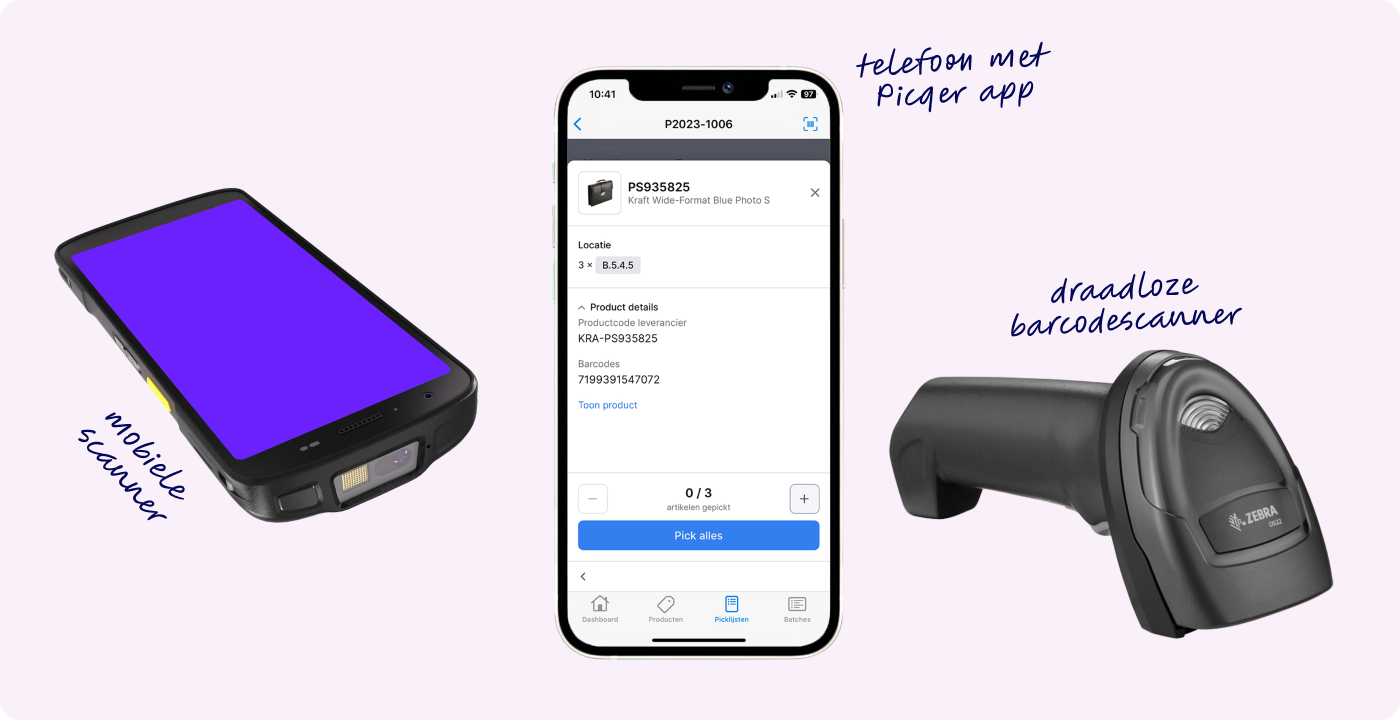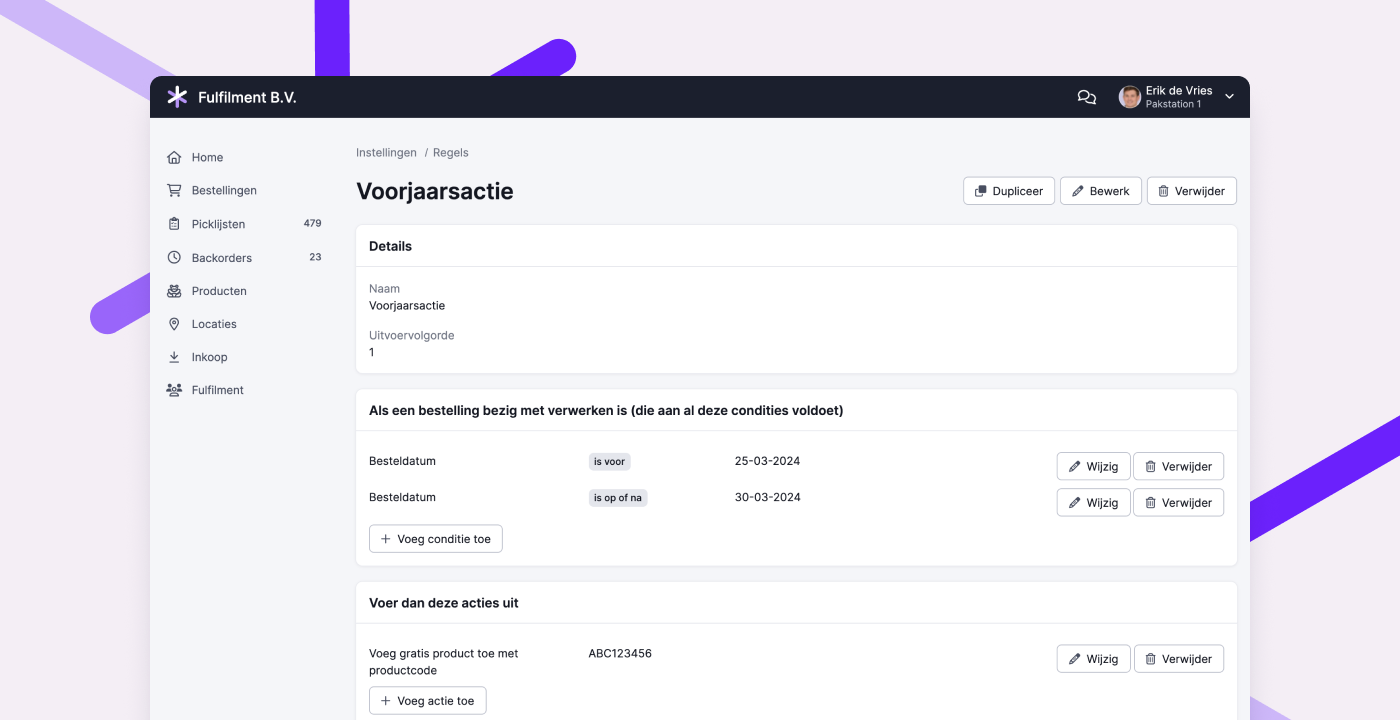Picqer Session #14: How do you invoice your fulfillment services?
On Thursday, April 25, we’re hosting a special Picqer Session dedicated to fulfillment. This session will focus on invoicing for fulfillment companies.
Invoicing is one of the most crucial processes for a fulfillment business. You earn revenue from the services and extras you provide in the warehouse, and you want to invoice that accurately and efficiently.
But how do you determine the pricing for your services? What costs can you charge your fulfillment clients? How do you apply pricing tiers? And how do you invoice for storage usage?
During this Picqer Session, Bob from Centralized will share his insights and real-world experience around invoicing in fulfillment. After the talk, there will be time for questions.
Do you find it tricky to invoice your fulfillment services properly? Or are you looking for ways to spend less time on billing? Then this session is for you.
Where and when
This Picqer Session takes place on Thursday, April 25, 2024, in Utrecht at Restaurant Dengh.
Visiting Picqer users
We regularly visit our customers to learn how they work, how their warehouses are set up, how they use Picqer, and what challenges they face. These visits are valuable for collecting feedback and sharing knowledge and ideas. In this article, we’ve gathered highlights from four different conversations and explain briefly how Picqer fits into each situation.
Processing orders more efficiently with software
“Before we used Picqer, orders came in through the webshop, we printed the packing slip manually and created the shipping label ourselves. Then we could pick the order. At the packing table, we had to match the correct shipping label to the packing slip. If you were chatting and forgot the name, you'd have to open the box again to check which packing slip was inside.” — Go-in-style.nl
With Picqer, this process is automated. Once your webshop is connected to Picqer, orders appear directly in the warehouse software. You pick items using picklists—either one at a time or in batches. Back at the packing table, after the picked products are checked, the correct shipping label is automatically printed. This ensures the right product is sent to the right customer.
Read the full story with Go-in-style.nl here.
Organizing your warehouse by category
“Since we sell a lot of seasonal products, we’re constantly adjusting our warehouse layout. We use the ABC analysis in Picqer to decide which products should be placed closest to the packing tables. We run this analysis monthly, because a lot can change month to month.” — Scala XL
Most webshops earn 80% of their revenue from 20% of their products. Those products should be stored in easy-to-reach locations that minimize walking time. With the ABC analysis in Picqer, you can smartly divide your products across your warehouse. Based on sales volume, items are sorted into three categories: the top 5% bestsellers are category A, the next 15% are category B, and the remaining 80% are category C. Place A products close to the packing table, B a bit farther, and C in the back. It’s a simple way to save time and effort.
Read the full story with Scala XL here.
Why we don’t offer custom features
“The only downside is that Picqer doesn’t offer custom features. Every business has its own needs. For us, it would be great if the purchasing system could account for seasonal trends. Of course, custom development would make the software much more expensive. I do appreciate that the software continues to evolve.” — Nutcrackers
Our goal is to help every webshop run a professional warehouse, whether you handle 50 or 2,000 orders per day. That’s why we focus on stable, ongoing development that benefits all users. We also share detailed documentation in our Help Center and publish insights on our blog.
Every warehouse has unique processes, preferences and tools. Maybe you use a packing machine, conveyor belt or forecasting system. To work efficiently, you can connect other tools to Picqer using our API. We’ve made it as comprehensive and user-friendly as possible. Plus, we offer many ready-to-use integrations.
Read the full story with Nutcrackers here.
Making smart use of data from Picqer
“We store both purchase and selling prices in Picqer. That means Picqer instantly calculates the margin. If I export all products from a certain supplier, I can see whether we’re dropping below our target margin. That helps me know exactly where to tweak things to stay profitable.” — IVOL
In Picqer’s reporting, you can view and export a wide range of data. How old is your inventory? What’s your monthly revenue? What are your costs? Which products perform well, and which don’t? This information helps you make better strategic decisions.
Read the full story with IVOL here.
Picking orders without paper
With 150 orders per day, that’s at least 150 sheets of paper. By the end of the day, they all end up in the recycling bin. That’s wasteful, and it’s not necessary. With warehouse software, you can pick orders entirely without paper. Less paper and ink saves unnecessary costs, and it's better for the environment too.
We see more and more warehouses making the switch to paperless picking—and we’re big supporters of that change. Here’s why.
Why go paperless when picking orders
- Digital workflows are much more flexible. While picking, you can view product information, make changes, and add comments. Your teammates can see updates right away. With paper, that’s not so easy. For example, if picklists are printed in the morning, it becomes difficult for customer service to make changes or leave a note later.
- When walking through your warehouse with a stack of picklists, you have to be careful not to mix them up or lose a sheet. With paperless picking, you don’t have to worry about that. Just make sure your battery is charged ;-)
- Tasks are presented step by step on your screen. You follow the instructions, without searching through paper. This makes it easy for anyone to get started—even if they’re new or not very tech-savvy. That said, we believe the software should be simple and guide users step by step.
What do you need?
The most important thing is a mobile device. It doesn’t have to be expensive or complicated. A phone or tablet that can open a picklist is often enough. If you want to verify products while in the warehouse, use a mobile scanner. In smaller warehouses where everything is within reach of the packing table, you could use a wireless barcode scanner connected to a computer. Just make sure your products have barcodes to scan.

A digital list of items to pick can be as simple as opening a webshop order on your phone. But if you’re using warehouse management software (like Picqer) or an ERP system, you unlock many more possibilities. You can not only generate digital picklists, but also guide your warehouse team from task to task.
Making the transition
It might not be realistic for every warehouse to quit using paper overnight. Reducing paper step by step works too. For example, group several orders into a single batch. That way, you print fewer picklists—and it also reduces walking distance. At the very least, make sure anything you do on paper is also recorded digitally. That way, your team stays in sync.
Picking paperless with Picqer
Paperless picking is easy with Picqer. You open the picklist in the Picqer app and collect the items in your warehouse. Back at the packing table, you check off the picked products on your computer, or scan each barcode to let Picqer verify the items. You can also use a mobile scanner to check products right at the shelf.
Want to try paperless picking with Picqer? Create a trial account and use Picqer free for 14 days.
Changelog: New conditions and actions for rules, and more updates
In recent weeks, we’ve introduced several improvements for date and time-based rules. Read more about these and other updates in this changelog.

Conditions based on order date and time
You can now set specific order dates or times as rule conditions. For both, you can choose from two options:
- The order was placed before the date or time
- The order was placed on or after the date or time
You can combine multiple conditions to trigger actions during a specific time frame. For example, you could offer a free gift for orders placed during a promotional period, or apply a different shipping method depending on the time an order was placed.
Snooze picklists for a set number of hours or until a specific date
When snoozing a picklist using a rule, you can now specify how many hours it should be snoozed. You can also set a specific date to resume the picklist. This is especially useful for pre-orders that should only ship on or after the product release date.
More control over printing packing slips
Previously, packing slips were always printed automatically if a packing slip printer was set up at the packing station. You can now decide whether to print packing slips at all. Using rules, you can override that default setting. This gives you full control and can save a lot of unnecessary paper.
Read more in the help article on printers and packing stations.

Other improvements
- Processing orders with many backorders and/or product compositions is now much faster.
- In the popup for creating a shipment, you now clearly see which shipping profile was preselected via a rule.
- We’ve added a new integration with Sendy.
- You can now quickly recognize which orders were placed via the fulfillment portal with a dedicated icon in the order overview.
- The shipping method “Small Parcel” from PostNL has been added to the MyParcel integration.
- When you turn a product into a virtual composition or mark it as having infinite stock, the ABC classification is removed.
- The graph on the customer page showing order history now always displays accurate data.
- A warning is shown if you try to leave a rule setup page without saving your changes.
- We now import QLS service points for orders from Shopify and Lightspeed, so the information is automatically passed to the carrier.
- When creating a purchase order via the API, you can now include a
delivery_date. - The track & trace URL for shipments to Belgian pickup points now works correctly again.
- The customer and supplier pages have been redesigned for improved organization and consistency with the rest of Picqer.
- The normal and singles batch pages have been updated for users who have enabled the experimental feature “Updated picklist and batch pages.”
New integration: Sendy
You can now connect Sendy to Picqer. Sendy is shipping software that helps you send orders quickly and easily. Orders are automatically converted into shipments, and the matching shipping labels are printed directly from Picqer.

What is Sendy?
Sendy’s shipping software makes your shipping process fast and simple. Orders are automatically converted into shipments with the carrier of your choice. The correct shipping labels are printed, and Track & Trace information is retrieved. Packed parcels can be picked up or dropped off at a nearby pickup point. Any customer questions about the shipment can easily be answered using the software.
What can you do with the integration?
- View all orders and their shipping status in one system.
- Use rules in Picqer to apply the correct shipping profiles.
- Orders are automatically converted into shipments with the matching label, which is printed directly from Picqer.
- Track & Trace information is automatically synced back.
- Answer customer questions about delivery directly in the software using Mijn vraag.
How to connect Sendy and Picqer
You don’t need any technical knowledge to set up the connection. Start by creating a free Sendy account, then connect Picqer from within your Sendy account. The step-by-step instructions are in our help article. Want to know which carriers and rates are available through Sendy? You can find that here.


